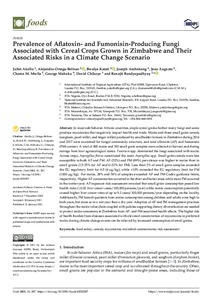| dc.contributor.author | Akello, J. |
| dc.contributor.author | Ortega-Beltran, A. |
| dc.contributor.author | Katati, B. |
| dc.contributor.author | Atehnkeng, J. |
| dc.contributor.author | Augusto, J. |
| dc.contributor.author | Mwila, C.M. |
| dc.contributor.author | Mahuku, G. |
| dc.contributor.author | Chikoye, D. |
| dc.contributor.author | Bandyopadhyay, R. |
| dc.date.accessioned | 2021-03-17T13:55:39Z |
| dc.date.available | 2021-03-17T13:55:39Z |
| dc.date.issued | 2021 |
| dc.identifier.citation | kello, J., Ortega-Beltran, A., Katati, B., Atehnkeng, J., Augusto, J., Mwila, C.M., ... & Bandyopadhyay, R. (2021). Prevalence of aflatoxin-and fumonisin-producing fungi associated with cereal crops grown in Zimbabwe and their associated risks in a climate change scenario. Foods, 10(2), 287: 1-18. |
| dc.identifier.issn | 2304-8158 |
| dc.identifier.uri | https://hdl.handle.net/20.500.12478/7083 |
| dc.description.abstract | In most sub-Saharan African countries, staple cereal grains harbor many fungi and some produce mycotoxins that negatively impact health and trade. Maize and three small grain cereals (sorghum, pearl millet, and finger millet) produced by smallholder farmers in Zimbabwe during 2016 and 2017 were examined for fungal community structure, and total aflatoxin (AF) and fumonisin (FM) content. A total of 800 maize and 180 small grain samples were collected at harvest and during storage from four agroecological zones. Fusarium spp. dominated the fungi associated with maize. Across crops, Aspergillusflavus constituted the main Aspergillus spp. Small grain cereals were less susceptible to both AF and FM. AF (52%) and FM (89%) prevalence was higher in maize than in small grains (13–25% for AF and 0–32% for FM). Less than 2% of small grain samples exceeded the EU regulatory limit for AF (4 µg/kg), while <10% exceeded the EU regulatory limit for FM (1000 µg/kg). For maize, 28% and 54% of samples exceeded AF and FM Codex guidance limits, respectively. Higher AF contamination occurred in the drier and hotter areas while more FM occurred in the wetter year. AF exposure risk assessment revealed that small grain consumption posed low health risks (≤0.02 liver cancer cases/100,000 persons/year) while maize consumption potentially caused higher liver cancer rates of up to 9.2 cases/100,000 persons/year depending on the locality. Additionally, FM hazard quotients from maize consumption among children and adults were high in both years, but more so in a wet year than a dry year. Adoption of AF and FM management practices throughout the maize value chain coupled with policies supporting dietary diversification are needed to protect maize consumers in Zimbabwe from AF- and FM-associated health effects. The higher risk of health burden from diseases associated with elevated concentration of mycotoxins in preferred maize during climate change events can be relieved by increased consumption of small grains. |
| dc.description.sponsorship | Food and Agriculture Organization of the United Nations |
| dc.description.sponsorship | Bill & Melinda Gates Foundation |
| dc.format.extent | 1-18 |
| dc.language.iso | en |
| dc.subject | Climate Change |
| dc.subject | Maize |
| dc.subject | Food Security |
| dc.subject | Food Safety |
| dc.subject | Cereals |
| dc.subject | Mycotoxins |
| dc.subject | Risk Assessment |
| dc.subject | Aflatoxins |
| dc.title | Prevalence of aflatoxin- and fumonisin-producing fungi associated with cereal crops grown in Zimbabwe and their associated risks in a climate change scenario |
| dc.type | Journal Article |
| cg.contributor.crp | Agriculture for Nutrition and Health |
| cg.contributor.crp | Grain Legumes |
| cg.contributor.crp | Maize |
| cg.contributor.crp | Roots, Tubers and Bananas |
| cg.contributor.affiliation | International Institute of Tropical Agriculture |
| cg.contributor.affiliation | National Institute for Scientific and Industrial Research, Zambia |
| cg.coverage.region | Africa |
| cg.coverage.region | Southern Africa |
| cg.coverage.country | Zimbabwe |
| cg.coverage.hub | Southern Africa Hub |
| cg.coverage.hub | Eastern Africa Hub |
| cg.coverage.hub | Central Africa Hub |
| cg.coverage.hub | Headquarters and Western Africa Hub |
| cg.researchtheme | Plant Production and Health |
| cg.identifier.bibtexciteid | AKELLO:2021 |
| cg.isijournal | ISI Journal |
| cg.authorship.types | CGIAR and developing country institute |
| cg.iitasubject | Aflatoxin |
| cg.iitasubject | Agronomy |
| cg.iitasubject | Climate Change |
| cg.iitasubject | Food Security |
| cg.iitasubject | Maize |
| cg.iitasubject | Plant Breeding |
| cg.iitasubject | Plant Health |
| cg.iitasubject | Plant Production |
| cg.journal | Foods |
| cg.notes | Open Access Journal; Published online: 31 Jan 2021 |
| cg.accessibilitystatus | Open Access |
| cg.reviewstatus | Internal Review |
| cg.usagerightslicense | Creative Commons Attribution 4.0 (CC BY 0.0) |
| cg.targetaudience | Scientists |
| cg.identifier.doi | https://dx.doi.org/10.3390/foods10020287 |
| cg.iitaauthor.identifier | Juliet Akello: 0000-0003-4780-4850 |
| cg.iitaauthor.identifier | Alejandro Ortega-Beltran: 0000-0003-3747-8094 |
| cg.iitaauthor.identifier | George Mahuku: 0000-0001-8444-8651 |
| cg.iitaauthor.identifier | David Chikoye: 0000-0002-6047-9821 |
| cg.iitaauthor.identifier | Ranajit Bandyopadhyay: 0000-0003-2422-4298 |
| cg.futureupdate.required | No |

